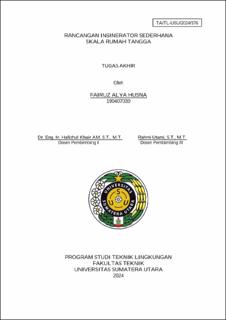Rancangan Insinerator Sederhana Skala Rumah Tangga
Design of a Compact Household-Scale Incinerator

Date
2024Author
Husna, Fairuz Alya
Advisor(s)
Khair, Hafizhul
Utami, Rahmi
Metadata
Show full item recordAbstract
Waste remains a major problem due to population growth, technological advances, and lifestyle changes. The large volume of waste is not matched by waste management facilities, leading many people to openly burn waste and producing dangerous pollutants. Using incinerators with air pollution control technology can be an effective solution to quickly destroy waste with minimal emissions. This research aims to design a simple, effective, and environmentally friendly household-scale incinerator, considering factors like combustion efficiency and low emissions according to applicable standards. The design method starts with literature review and secondary data collection, selecting the design and materials used. Then, calculations and design creation are done using Autodesk Fusion 360. Based on the calculations, combustion process simulations were performed using Aspen Plus, and air and thermal distribution simulations were conducted using Autodesk CFD until the simulation results met the applicable standards. In the final stage, the design drawings were made. The result of this design is a single-chamber incinerator with a capacity of 5 kg or 21 L, a diameter of 38 cm, and a height of 69 cm. It is equipped with a high-efficiency Stairmand cyclone scrubber with a diameter of 21 cm, using 10 L/h of water at the cyclone inlet to capture and reduce the temperature of the exhaust gas. Simulation results using Aspen Plus show emissions of 0.028 m³/s, with parameters for total particulates, CO, SO₂, and NOx below the standards set by Permen LHK No. 70/2016. The cyclone scrubber's removal efficiency is 99.93% for total particulates, 100% for CO, 35% for SO₂, and 35.11% for NOx. The air and thermal distribution simulation results using Autodesk CFD show airflow velocity in the combustion chamber ranging from 0.25 to 2 m/s, in the duct between the combustion chamber and cyclone scrubber from 6 to 8.9 m/s, and within the cyclone scrubber from 1 to 5 m/s, with temperatures in the combustion chamber ranging from 460 to 500°C and in the chimney from 70 to 180°C
Collections
- Undergraduate Theses [404]
